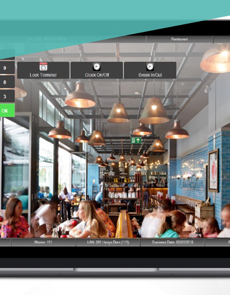Guide to the best EPoS Systems for restaurants in the UK 2025
With operating costs soaring, hospitality business owners need to make sure the software they choose provides the best value for money and ultimately will help streamline operations. So, when choosing a new EPoS system for your business – how do you choose the best one?
Our Access Hospitality software specialists speak to hundreds of business operators looking to upgrade or improve their current EPoS system, and they consistently tell us what features they are looking for, such as how it integrates with other business software and how it can help with kitchen management. So, we’ve asked our team to help us put together this definitive guide on how to choose the best EPoS system for pubs, bars, restaurants and other hospitality businesses.
Read on to explore the key elements and characteristics of different hospitality EPoS solutions and their respective benefits and challenges. We’ll look at the things you should take into consideration when choosing your next EPoS solution.
Guide to the best EPoS systems
Types of restaurant EPoS software
An EPoS (Electronic Point of Sale) system is a combination of hardware and software designed to manage transactions, inventory, track sales and provide real-time reporting.
However, you should know that there are different types of EPoS software that each have their own merits to consider.
Key considerations when choosing restaurant EPoS software
The key considerations when choosing restaurant EPoS software include the features and functionality of the software, its ease of use and reliability, compatibility with hardware and other systems, cost and ongoing support, as well as integrations with third-party systems and data reporting and analysis capabilities.
In this section, we’ll explore each of these key considerations in more detail:
1. Cost
Cost is a huge driving factor when it comes to choosing an EPoS system, and cheapest certainly doesn’t always mean best. Depending on the specific needs of your operation a variety of factors may influence the cost of an EPoS system, including monthly fees, up-front costs and hardware costs.
Scale of enterprise may play a part, with discounts being applied across more units. So, what works for a large multi-site operator might be hugely different to what suits an SME.
You can read more about what drives the cost on an EPoS system for pubs, bars, restaurants and other hospitality businesses in our How much does a restaurant PoS system cost article.
2. Key features
What do you want from your ideal EPoS? Is it simply to process customer orders? Do you need a wealth of deep-dive data that will help drive performance insights about your business? Maybe you’re looking to improve the customer experience – speed up order times and digitise the ordering process?
The answer to this question will help you understand which features are important to you. Here, we’ll look at some of the most common features of hospitality EPoS systems:
- Order Management
Order management features in hospitality EPoS systems help to effectively and efficiently manage customer orders and streamline the fulfilment process. This might include features such as order tracking, order routing, order splitting and order prioritisation, which all help reduce errors, minimise kitchen wait times and improve overall customer satisfaction. These features can also help kitchen staff to work more efficiently and reduce the time and effort required for order management, allowing them to focus on preparing high-quality meals.
- Menu Management
With the right menu management features, businesses can easily create and manage menus, modify items and adjust pricing in real-time. A well-designed interface allows staff to easily access and amend menus, ensuring that menus are always up-to-date and accurate. Additionally, menu management features can help improve the customer experience by allowing guests to place orders through a digital menu or self-service kiosk and can provide upsell opportunities with suggested add-ons or meal deals.
- Inventory Management
Manual inventory processes can take a lot of time for kitchen staff, reducing the time available for other kitchen tasks. Manual records can also be less accurate and lead to more wastage by not having a quick access record of what food is available and when it needs to be used. An EPoS which also includes inventory management can make it much easier to monitor stock levels and track usage in real-time, so you never run out of items unexpectedly or waste a lot of unused stock. You can also identify your bestselling items and adjust your menu accordingly, so you are always providing the best dishes to your customers.
- Payment Processing
The EPoS system for a restaurant or food-based hospitality business needs to be able to support all kinds of payment types in venue but also may need to support online payments and payments through third-party delivery partners. So, your system needs to be robust and able to be easily updated to support the ever-increasing digital payment methods customers use. And with digital payments you also must consider the security measures that protect customer and business data and prevent fraud. In addition, you may need a system that can cope with the flexible nature of food-based hospitality businesses – which might include open tabs, bill splitting and being able to apply discounts and promotions automatically.
- Reporting and Analytics
With access to real-time sales data you can create actionable insights to help you improve business performance by generating reports on sales, inventory and staff performance. Your chosen system should also enable you to analyse your sales data to pick out your best and worst performing products or identify your best sales performance dates and help you make informed decisions.
The EPoS features you need for your operation will depend on the size, budget and operational needs of your business. When assessing the key features of an EPoS system that you are considering investing in, ask yourself how that feature would benefit, improve or optimise your current processes. There are other things that you might also consider, such as scalability of the solution as your business grows or ongoing customer support over time.
3. Integrations
You probably already have a whole stack of tech that’s supporting your business operations – so it’s important to consider the integration capabilities of your new EPoS system so that you can create a cohesive and efficient ecosystem of software tools that work together seamlessly.
System integrations can help you optimise your operation by automating various processes, reduce errors and increase efficiency across the business, leading to improved productivity and profitability.
For example, a restaurant may benefit from a payment processing integration to accept various forms of payment, an inventory management integration to track ingredients and reduce waste, and an online ordering integration to increase sales and offer customers a convenient ordering process. A pub or bar may benefit from a staff management integration to optimise staffing levels and reduce labour costs, and a loyalty program integration to encourage repeat business and increase customer lifetime value.
Choosing a system that supports these key integrations enables you to leverage the power of multiple software tools and create a streamlined workflow:
- Inventory Management Integration: By integrating the EPoS with an inventory management solution, businesses can more easily manage their inventory levels, monitor stock levels and track sales trends. By doing so, businesses can make informed purchasing decisions, reduce waste and inventory costs and improve their profitability.
- Staff Management Integration: Businesses that are able to integrate their EPoS with staff management tools can manage staff schedules, monitor employee performance and track labour costs. By doing so, businesses can optimise staffing levels, reduce labour costs and improve staff performance and customer service.
- Online Ordering Integration: By enabling businesses to accept orders from online channels such as their website, social media platforms and third-party ordering apps businesses can expand their reach, increase sales and improve the customer experience by offering a convenient and seamless ordering process across multiple platforms.
- Loyalty Program Integration: This integration enables businesses to create and manage customer loyalty programs. By doing so, businesses can incentivise repeat business, encourage customer loyalty and increase customer lifetime value.
What is the best EPoS system software for your restaurant?
Choosing the best EPoS system for a restaurant or hospitality business can be a challenging task as different types of businesses have different requirements. It’s essential that the system you choose meets the specific needs of your business, for example, the ability to support different order and payment solutions or optimise kitchen processes. Additionally, the system should be easy to use and navigate for both staff and customers.
To help you choose the EPoS system for your restaurant or hospitality business, we’ve rounded up some of the best EPoS solutions available and listed some of the pros and cons of each:
*Prices are correct as of February 2025. For the most accurate and up-to-date pricing information, please contact the providers directly.
*Please note that the "Best for" column is a general guideline and businesses should assess their own needs and requirements before making a decision. Additionally, pricing and features may vary depending on the specific package or plan chosen.
Best EPoS systems for big restaurant chains
When choosing an EPoS system for a large hospitality estate, it is important to consider scalability, integration capabilities and centralised management.
The system should be able to handle a large number of transactions and be easily scalable to accommodate additional locations. It should also integrate with other systems used by the business, such as accounting software, inventory management systems, and loyalty programs.
A centralised management system is also important, allowing for streamlined operations and reporting across multiple locations. Additionally, the system should have strong security features to protect customer data and prevent fraud.
Checklist for large restaurants and chains:
- Determine the unique requirements of your business and identify any pain points.
- Evaluate the scalability of the system to accommodate business growth and expansion.
- Consider the system's integration capabilities with other tools and software used in your operations.
- Ensure the system is user-friendly and can easily train new employees.
- Assess the system's security features to protect against cyber threats and data breaches.
- Determine the level of customer support and service offered by the provider.
- Large businesses may be able to negotiate better pricing with providers, but it is important to choose a system that fits within the business's budget in the long-term.
- Advanced reporting and analytics capabilities are essential to track performance across multiple locations and make informed business decisions.
- Research the provider's reputation and track record in the industry.
Best EPoS systems for small restaurants
Smaller restaurant and hospitality businesses should consider several factors when choosing an EPoS system that meets their needs. Firstly, they should look for a system that is easy to set up and use, with a user-friendly interface that is easy to navigate.
The system should support basic key features such as menu management, order management and inventory management, as well as the ability to process payments. It should also be able to integrate with accounting software, loyalty programs, and online ordering platforms.
Smaller businesses should carefully assess their budget and their plans for the future in terms of expansion and choose a software supplier who can grow with them as they develop their business, with the ability to handle increased traffic, additional locations, and more complex operations.
Checklist for SMEs and independent businesses:
- Determine your business needs and goals.
- Consider the size of your business and the number of sites.
- Assess your budget and ongoing costs.
- Evaluate the features and functionality that are essential for your business.
- Ensure the system is easy to use for both staff and customers.
- Check the compatibility with other systems you use, such as accounting or inventory management software.
- Look for an EPoS provider with good customer support options.
Ready to optimise your business through the till?
In this article, we’ve explored all the things you should consider if you’re looking to choose the best EPoS system for your restaurant, pub, bar or hospitality business. We’ve looked at the different types of EPoS system and how they might benefit your business as well as taken a deep dive into the key features you should look out for when choosing your next hospitality EPoS solution.
Access EPoS offers a highly configurable and reliable EPoS solution that is easy for your teams to use and delivers intuitive automatic upselling prompts and product details to boost customer service and profitability, drives optimised communications between your front and back of house for faster and more accurate service times and helps you optimise processes to manage ordering, recipe costing and reduce waste, saving you money.
Ready to find the perfect EPoS for your restaurant? Book a demo now.
Get your restaurant working faster and smarter with EPoS
More about EPoS
Related resources to support you in driving efficiency and running a more profitable business

 AU & NZ
AU & NZ
 SG
SG
 MY
MY
 US
US
 IE
IE





